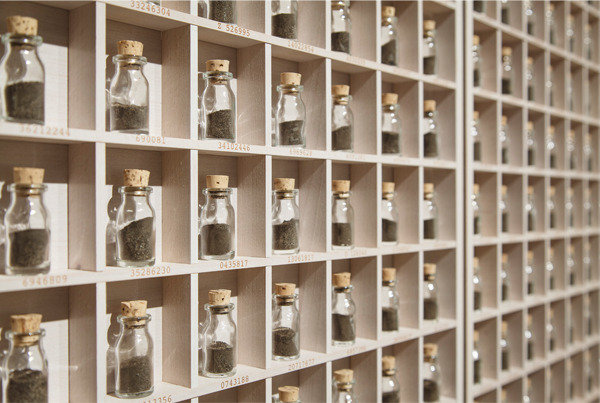Nadia Kaabi Linke
dal 12/10/2014 al 28/11/2014
Segnalato da
12/10/2014
Nadia Kaabi Linke
Mosaic Rooms, London
The Future Rewound & The Cabinet of Souls. The exhibition is formed in two parts: the first reflects upon these last 100 years and the structures of power that thread colonialism and capitalism, the second explores enduring methods of control in contemporary life.

The Mosaic Rooms are pleased to present the first UK solo show by Nadia Kaabi-Linke. The Future Rewound & The Cabinet of Souls features recent work and specially commissioned site-specific installations.
The exhibition is formed in two parts, both inspired by the history of the gallery’s building. More than a century ago, the house served as the domicile for Imre Kiralfy, the man responsible for many of the grand exhibitions at Earls Court, White City and Olympia. Kiralfy brought ‘curiosities’ from across the global empire to England, where the Victorian public was eager to view foreign spectacles. In dynamic new work that directly responds to the space, Kaabi-Linke reflects upon these last hundred years and the structures of power that thread colonialism and capitalism, captivity and control, the observed and observing.
In the upper gallery, The Future Rewound explores enduring methods of control in contemporary life. No is a two-channel video installation which focuses on the rigorous visa process that people go through to enter the UK. Modulor II takes its name from an anthropocentric scale invented by architect Le Corbusier, whose harmonious balance of proportion is challenged in this installation, which recreates the minimum measurements of prison cells from across Europe. All Along the Watchtower uses shadow as architectural form to evoke undetectable surveillance structures, while Perspectives (Bank Junction, London) is a new work that addresses the recent financial crisis and omnipotent influence of capitalism. A Colour of Time is a new monochrome piece, which visualises the layers of time of the building’s history, after architectural exploration revealed that layers of paint from Kiralfy’s time still existed.
The Cabinet of Souls inverts the roles of spectators and objects. The works make visible the ghostly shadows that continue to influence social forces today. In a new commission, Faces, the artist appropriates archival photographs of tribes people brought to London for the ‘Savage South Africa’ spectacle that formed part of Kiralfy’s Greater Britain Exhibition in 1899. By re-portraying such figures in the manner of Victorian portraiture, the artist re-invests each person with individuality, while simultaneously invoking the camera as a tool of Western imperial control. In Tunisian Americans, vials of the soil that surrounds 400 US military graves in Tunisia are placed within old type cases and labelled with their corresponding social security numbers. Kaabi-Linke archives the very earth of her native soil, and through this act addresses the tension in recalling and ordering histories of conflict. Impunities London Originals similarly negotiates visibility, using forensic methodology to render discernable the scars of domestic violence, physical and psychological – trapped as traces on fragile paper.
Winner of the recent 2014 Art Basel Discoveries Prize, Nadia Kaabi-Linke’s extraordinary practice relates to the way geography and politics inform the identity of both the individual and the collective. Nadia Kaabi-Linke is a Tunisian Russian artist who was born in 1978 in Tunis. She studied at the University of Fine Arts, Tunis (1999) before receiving a PhD from the Sorbonne, Paris (2008). Her last solo exhibitions were In confinement my desolate mind desires (2014) at Art Basel, Hong Kong; Stranded (2014) at Gulbenkian Foundation, Lisbon, Portugal; No One Harms Me (2013) at Experimenter, Kolkata, India; Black is the New White (2012) at Lawrie Shabibi, Dubai, UAE; and Tatort/Crime Scene (2010) in Berlin, Germany. She has participated in group exhibitions at The Museum of Modern Art, New York, USA; the Nam June Paik Art Center at Seoul, Korea (2013); the Liverpool Biennial, UK; Herbert F Johnson Museum, Ithaca, NY, USA (2012); 54th Venice Biennial in Italy (2011); and 9th Sharjah Biennial in Sharjah, UAE. In 2011 she was commissioned by the City of Berlin, borough of Neukölln, to make an out door sculpture for the square Alfred Scholz. The public Artwork “Meinstein” was inaugurated in 2014 . Her works are part of several public and private collections including that of MOMA, New York.
To deliver our regular series of public events The Mosaic Rooms are collaborating with partner institutions including the ICA, Goethe Institut, Leighton House , Freeword Centre and Iniva. These will offer opportunities to hear from the artist herself, as well as critically discuss the multi-faceted questions raised by the dynamic work of the exhibition, visit our Talks & Events page.
The Mosaic Rooms is a cultural space in West London showcasing the most exciting, progressive and creative voices from the Arab world. As the UK arm of the A.M. Qattan Foundation, it aims to reveal aspects of Arab society that are often not covered by the media, with the view that culture, in its widest and most generous definition, plays a vital role in facilitating cross-cultural dialogue and understanding.
The Mosaic Rooms are an A.M Qattan Foundation project. You can read the A.M Qattan www.qattanfoundation.org
Special Events:
10 Oct, 1pm "Culture Now: Nadia Kaabi-Linke"; the artist discusses with Lorenzo Fusi
Private Preview 13 Oct, 6.30pm - 8.30pm
The Mosaic Rooms
A.M. Qattan Foundation Tower House, 226 Cromwell Road London SW5 0SW
Open Tuesday – Saturday, 11am – 6pm, Entrance Free



